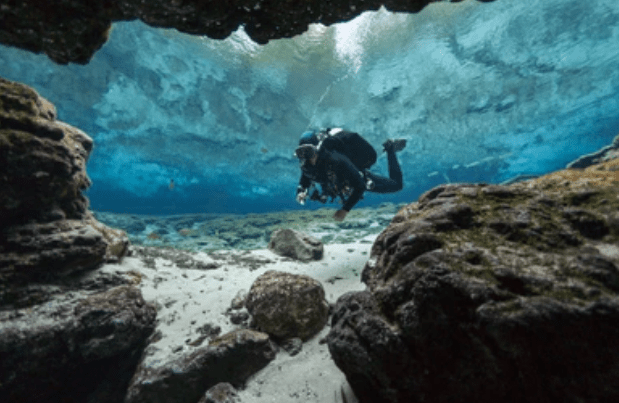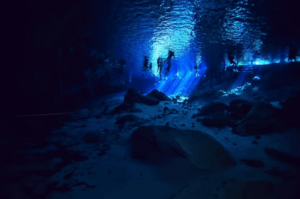5 Best Warm-Weather Cave Dives in the World

Cave diving in warm-weather destinations offers a unique combination of thrilling exploration and pleasant diving conditions. These caves not only provide an adrenaline rush but also showcase some of the most stunning underwater landscapes on the planet. Here are ten of the best warm-weather cave dives, along with the best times to visit, what makes each dive so special, and important safety tips.
Best Time to Dive: November to April
Destination Details: Located in the Yucatán Peninsula, Cenote Dos Ojos is renowned for its two interconnected sinkholes resembling two large eyes. The cenote’s clear blue waters offer incredible visibility, revealing intricate limestone formations and allowing divers to experience the magical play of light and shadow. The underwater caverns are filled with stalactites and stalagmites, making every dive a journey into an otherworldly realm.
Best Time to Dive: April to June
Destination Details: The Great Blue Hole is an iconic dive site off the coast of Belize. This massive marine sinkhole, over 300 meters wide and 125 meters deep, is part of the Belize Barrier Reef Reserve System. Diving here offers the thrill of descending into the deep blue abyss, where you can explore fascinating stalactite formations and encounter diverse marine life, including reef sharks, groupers, and parrotfish.
Best Time to Dive: November to April
Destination Details: Sistema Sac Actun, the world’s longest underwater cave system, is another gem in Mexico’s Yucatán Peninsula. With over 347 kilometers of mapped passages, this cave system provides endless exploration opportunities. Divers can navigate through a labyrinth of tunnels, admire the impressive stalactites and stalagmites, and swim in crystal-clear waters, creating a truly surreal experience.
Best Time to Dive: November to May
Destination Details: Located on Grand Bahama Island, Ben’s Cave is part of the Lucayan Caverns, the largest underwater cave system in the Bahamas. The cave features a unique mix of fresh and saltwater, known as a halocline, which creates mesmerizing visual effects. Divers can explore beautiful rock formations and encounter unique marine life, making it a fascinating and picturesque dive.
Best Time to Dive: November to April
Destination Details: Cenote Angelita is famous for its eerie underwater river. At a depth of around 30 meters, there’s a layer of hydrogen sulfide that creates the illusion of a flowing river complete with fallen trees and leaves. Diving here is like entering a ghostly, otherworldly realm, offering a truly unique and unforgettable experience.

Safety Tips for Cave Diving
- Get Proper Training and Certification: Cave diving requires specialized skills. Ensure you complete a cave diving certification course from a recognized diving organization.
- Use the Right Equipment: Cave diving gear includes redundant air supplies, primary and backup lights, a guideline reel, and appropriate exposure protection. Always check your equipment before each dive.
- Plan Your Dive: Thoroughly plan your dive, including entry and exit points, gas management, and navigation. Stick to your plan and avoid exceeding your limits.
- Dive with a Buddy: Always dive with a buddy who is equally trained and experienced in cave diving. Maintain close communication and visual contact throughout the dive.
- Follow Guidelines and Rules: Use guidelines (a reel and line) to mark your path and ensure you can find your way back. Never stray from the guideline.
- Monitor Your Air Supply: Keep a close eye on your air consumption and ensure you have enough air to return to the surface safely. Follow the “Rule of Thirds” for air management: one-third for the way in, one-third for the way out, and one-third as a reserve.
- Stay Within Your Limits: Know your limits and avoid pushing them. Cave diving can be unpredictable, and it’s essential to dive conservatively.
- Check Weather and Water Conditions: Ensure conditions are suitable for cave diving. Strong currents, poor visibility, and bad weather can increase the risks.
- Emergency Procedures: Be familiar with emergency procedures, including air-sharing, lost line drills, and lost buddy protocols. Practice these skills regularly.
- Maintain Physical Fitness: Cave diving can be physically demanding. Ensure you are in good health and maintain a reasonable level of fitness.
Exploring these warm-weather underwater caves offers a blend of thrilling adventure and breathtaking beauty. Each destination provides a unique glimpse into a hidden world, making cave diving an unforgettable experience for those who seek it. Always prioritize safety to ensure your cave diving adventures are both exciting and secure.
